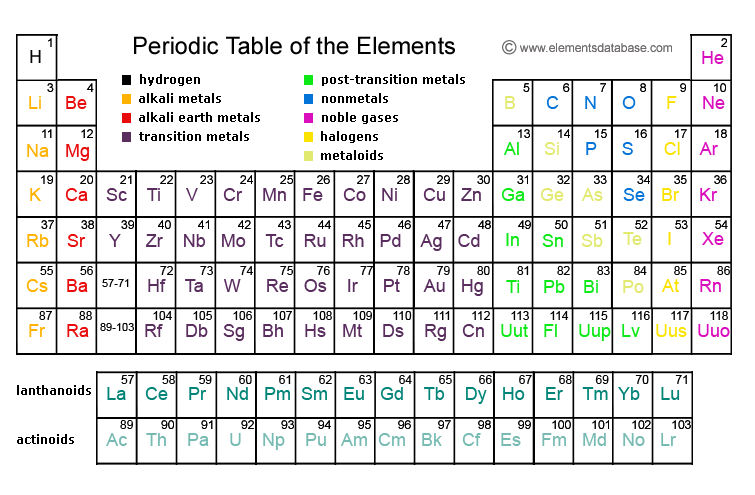Hi people! I'm back! I always start with word hello or hi. Haha
I’m going to explain about periodic table today.
What is periodic table?
Periodic table is a list of all the chemical elements that occur is the universe.

If you see the periodic table, you might see 118 squares(well, there are 110 on this...), which means that there are 118 of elements discovered.you see each of the square,right? There will be alphabet, and numbers in the square.
For example of Oxygen, there is O at the middle of the square and 8 on the top and 16 15.99 on the bottom. O means the oxygen. The letter on the middle is the abbreviation of the element. For Hydrogen and Helium, the element on the front gets the first letter H and the last element gets the first letter and second letter H and E, and then put it together to make HE. The number on the top of the square which is 8, is the atomic number of that element. Atomic number is number of protons, and this is also number of electron of that oxygen, because with no exception, electrons have same number of protons have. So Oxygen has 8 protons and electrons. The number on the bottom is the mass number. This tells how heavy the oxygen is. The mass of the atom is the mass of nucleus(protons + neutrons). So oxygen has 8 protons and 8 nucleus, and the mass of those are about 15.99.
 Dmitri Mendeleev is a Russian guy who created periodic table.He also predicted some of elements that wasn't discovered yet, and he made empty spot for undiscovered elements.
Dmitri Mendeleev is a Russian guy who created periodic table.He also predicted some of elements that wasn't discovered yet, and he made empty spot for undiscovered elements.He arranged the periodic table as period and groups. Group is the vertical line of the periodic table and there are 18 groups. Period is a horizontal line of the periodic table. There are 7 periods. Period is arranged by the number of electrons. At a single atom, there are electrons that has 2 on the first electron shell, 8 on the next one and going on by 8 electrons. 2,8,8,8,8... is the most stable way to bond it self together. So the by the number of electron shell changes, periods change.

Periodic table is made up of metal and non-metal. Metal is located on left and middle of periodic table and non-metal is on the right of the periodic table. two-third of the periodic table is metal and rest of em is non-metal.
Inside that, there are
Alkali metals like sodium. Alkali metal can react with water to produce alkaline solutions. (1 group except Hydrogen)
Alkaline-earth metals is like calcium. It also produce alkaline solutions when it combined with water and are found all over the place on earth.(2 group)
Transition metals like iron. They are strong and shiny. (3~12 groups)
Poor metals like led. They are soft with low melting points.
Semi metals like silicon conduct electricity only under certain conditions and are useful in electronics.
Nonmetals have a variety of properties. It include the carbon, nitrogen,and oxygen vital to life on Earth.
Nobel gases like helium and neon. It have outer electron shells that are full, and so they don't often react with other elements.
Yeah! I'm done! Are you happy with it? I hope you do! Next week. I will come up with other science topic!!Thank you for reading this and I hope this solved your questions! Bye~
god job! great information, good pictures. but i dont think you needed both pictures of the periodic table tho. :) overall 98%
ReplyDeleteGreat job! I really liked it; you imrpoved a bunch since your other blogs. The pictures were realy good too. I'd give you an A!
ReplyDeletebeautiful! so organized! 95% A
ReplyDeleteGrade: A but resize the pictures to fit on the blog. Besides that it was great!
ReplyDeleteI liked the pictures and the background, but I add more info. Grade: A
ReplyDeleteahhh THANKS! I got A's~~
ReplyDelete